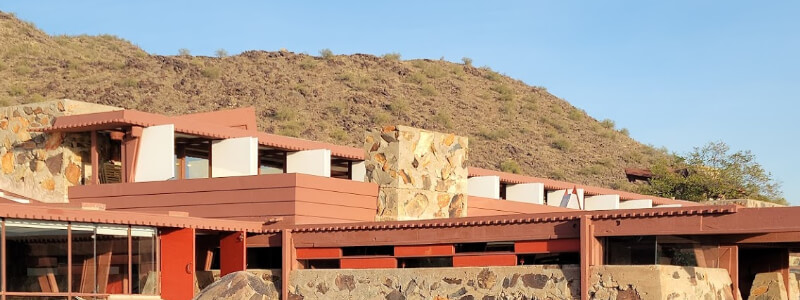Arizona Desert and Frank Lloyd Wright
Frank Lloyd Wright’s Taliesin West offers a striking example of the architect’s theory of organic architecture applied to the stark but beautiful southwest desert.
By the time Wright set up camp in Arizona in 1928, certain themes had been expressed in a variety of lyrical buildings. Very much concerned with beauty, Wright had developed a style that emphasized a balance of natural forms, the transformation of interior space into something flowing and dynamic, a tasteful play of primary colors in rich hues, and the use of natural materials.
What resulted at Taliesin West was a series of terraces, breezeways, courtyards, and rooms at times open, airy and spacious, or small, intimate and cave-like, all set on a starkly angular plan. It was the expression of Wright’s famous principles of organic architecture in an entirely new and untried environment.
The Big Themes of Organic Architecture
Wright had developed these principles over the course of forty years. His criteria included: Simplicity and repose; that the site is incorporated into the design; that the building expresses the owner’s individuality; that the colors be drawn from nature; that the building is true to its nature and materials; and that the building expresses spiritual integrity.
Moreover, Wright’s big themes – the hearth and the low sheltering roof – were incorporated here, as was his early idea of “articulating the continuity of space,” of opening up rooms so that they flow into one another, making space dynamic. He achieved this through contrasting high and low ceilings, through “working away at” the wall, and by building in extended vistas between rooms. The entire enterprise illustrates one of Wright’s earliest ideas – the “destruction of the box.”
Architectural Spaces Evoke Cave and Canyon
Walking through Taliesin West, evidence of Wright’s philosophy are everywhere tangible. The most striking aspect lies in the materials, in particular the stones from which the walls are formed. Hauled in from the mountainside, they were placed into large frames with a quantity of desert sand and then covered with concrete which, when dry, formed massive if often low stone walls that appeal to our most primitive sense of shelter.
Some spaces are cave-like with only small clerestory windows for light. Others, as in the wide breezeways, exude the essence of canyon passes in shifting patterns of shade and sun. This is the bedrock of the place, figuratively and literally. Along with rock, the next most prevalent materials here are wood beams and canvas, this latter stretched tight on frames to form slanting roofs. Together the beams and canvas formed a great tent of stone, wood, canvas, and textiles.
Incorporating Site into the Design
Wright followed his principles of organic architecture with other aspects of the buildings as well. The broad vistas over the valley, the buffer of the mountains to the east, and the stillness of the desert create a haven of simplicity and repose for the visitor. This is enhanced by the way the site is incorporated into the design; low walls meld into the landscape while the geometric forms echo the mountain peaks. As for color, everywhere the reds, oranges, tans, and whites are mirrored in the surrounding desert strewn with a carpet of sand and multi-colored rocks.
Taliesin West is, at heart, a primitive camp, an elemental manifestation of Wright’s principles of organic design as applied to the desert environment. But it is also a dynamic interplay of modern design, art, and the primitive. A step into Taliesin West propels the visitor back to the remarkable years of modernism, then further back to Arizona’s historical past, and finally to the deep geological past embedded in the very substance of this place.
References
- Bruce Brooks Pfeiffer, Frank Lloyd Wright’s Encounter with the Arizona Desert (Taliesin West, Scottsdale Arizona: Frank Lloyd Wright Foundation, Winter, 2005), 5-7.
- Eric Peter Nash, Frank Lloyd Wright: Force of Nature. New York: Todtri, 1996.
Taliesin West
12621 N Frank Lloyd Wright Blvd
Scottsdale, AZ 85259

